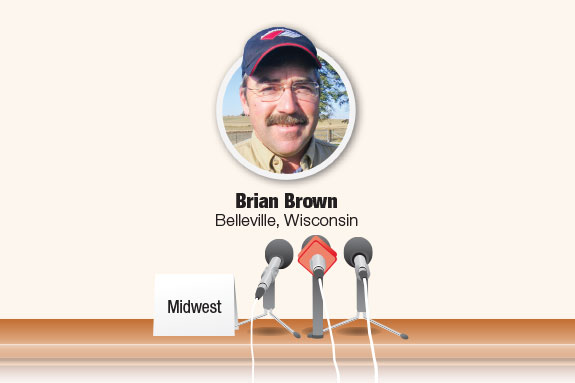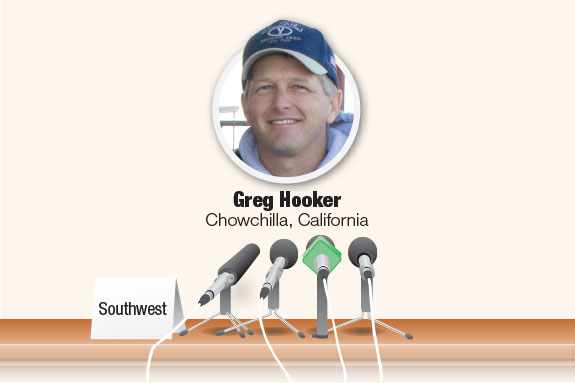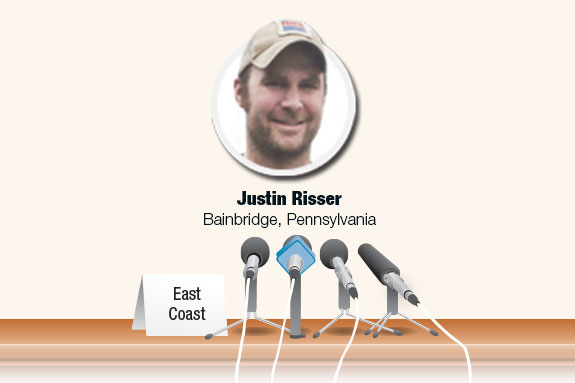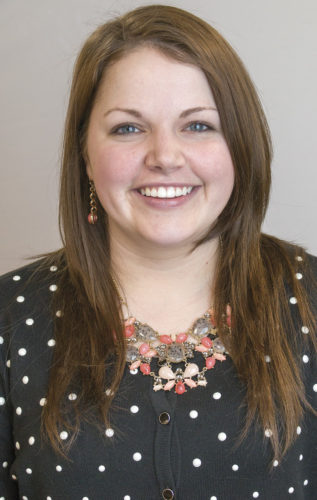Our progressive panel participants have provided responses for one last roundtable discussion about managing herd and hoof health issues. We’d like to thank the participants for opening up about their operations for five issues of the magazine, and also sharing with us their best management practices for calf and heifer raising, manure handling, breeding and feed and nutrition. Each family will receive a Proud to Dairy cooler and Progressive Dairyman hats.
If you’re interested in participating in future roundtable articles, click here to email Emily Caldwell.

How do you manage fresh cow facility flow or overcrowding?

BROWN: We try to keep our pre-fresh and post-fresh areas at 80 percent stocking density.
We also schedule events so it will be less stressful on the cattle. That means we may move sooner or later than our scheduled times.
HOOKER: We have two fresh pens: one for fresh heifers and one for cows. We move animals directly from the maternity pen to the fresh pens.
They stay in there for about 18 to 26 days. We’ve recently changed protocol in stocking rate, and we aim for a maximum of 95 percent. It usually averages 70 to 90 percent. The rest of the dairy is usually at 105 or 110 percent.
RISSER: Fresh cows are kept in a post-fresh group and on a specific ration. We keep fresh heifers in this group for three weeks and cows for a minimum of two weeks. Any cow that transitioned harder than normal, whether she dealt with lameness, heavy ketosis, LDA or metritis, usually will stay in the post-fresh group longer than the normal cow.
Keeping healthy fresh cows keeps this group from getting overcrowded. We don’t overcrowd this group, and usually we are only 80 percent stocked for post-fresh cows.

What is your fresh cow treatment protocol?
BROWN: Fresh animals are in a post-fresh pen and are monitored for at least a week. We’re monitoring milk, temperatures and feed intakes during that time.

HOOKER: Starting last October, we began giving all fresh cows a Bovikalc bolus right at freshening to help with clinical and sub-clinical milk fever.
We’ll monitor those cows, and if we see a retained placenta or other clinical signs, we’ll give them a second bolus.
The fresh heifers aren’t receiving a special supplement at this time, and we don’t monitor temperatures. We do observe those heifers and palpate frequently.
For sick heifers or cows, we’ll give an Excede or Excenel treatment. If the animals don’t respond after three days, they’re put in the hospital pen and put on Polyflex.
RISSER: Fresh cows are monitored daily for general appearance, rectal temperature, urine-ketone, appetite and udder fill for one week. After they are one week fresh, they are still watched but not monitored as hard.

We choose to treat LDAs with laproscopic surgery done by our veterinarian. Metritis is treated using either Excede or Polyflex, depending on severity.
Ketosis is tricky. Diagnosing primary versus secondary has been our approach to determine how to treat.
If secondary (whether lameness, a fever, indigestion, etc.) is causing her to not eat, we treat the primary and the ketosis goes away.
If it’s a suspected primary ketosis and we can’t find anything else wrong with her, we drench orally and watch performance. We don’t get caught up on the color of the ketone stick.
She may stay red or purple for days, but as long as appetite and udder fill is good, we choose to ignore it and quit treatment and let her overcome it naturally with increased intake.

What one or two things could you not do without that are key to ensuring fresh cow health?
BROWN: We have a separate area for fresh cows and monitoring their temperatures.
HOOKER: This is something that’s been in place a long time, but the best thing for us in fresh cow health has been having separate fresh pens. When we first built the dairy, I knew we needed to plan for that and have separate pens for cows and heifers.
It’s really helped us to focus on the animals that need the attention. We can identify sick cows more quickly and respond faster. It’s really helped our fresh cows get off to a good start.
RISSER: We wouldn’t have our great fresh cow health without a few things. The things I couldn’t do without are very comfortable sand-bedded stalls, sprinklers for pre-fresh and post-fresh cows and good, lush, fresh cow hay. We focus on buying good hay and it pays in a low LDA rate.

What one thing would you bet your vet would tell you could be improved about your fresh cow program?
BROWN: I asked this question of our vet, Dr. Berry Kleppe of Waunakee Vet Service. He felt that on days with multiple cows calving, we could benefit from a larger maternity area.
HOOKER: I wouldn’t have said this was a good idea two months ago, but our vet recommended we take our stocking density down in our fresh pens to 75 to 80 percent. We were only at 100, sometimes 105 percent, so this was something I resisted at first.
But we did, and I could see a difference right away. Even though you have to overstock some other areas of the dairy to allow you to reduce numbers in the fresh cow pens, it’s worthwhile.
As far as other improvements, I think our vet might suggest some changes in tracking dry matter intake in our pre-fresh group. There are probably some things we could do to make sure those cows are getting enough intake.
RISSER: My biggest frustration lies in having my 2-year-olds freshen incredibly well for a while, then having a group transition lackluster. I’ve yet to pinpoint the issue, but I like to get my 2-year-olds off to a good start because I know it drives a higher peak. A lot of our metabolic are at very acceptable levels, so I don’t think my vet is too concerned about our fresh cow performance.

What have been some things you’ve done to improve hoof health in your herd?
BROWN: We have done numerous things. Number one is selecting genetics that promote sound feet and legs in the cattle. We enhance that with good foot surface and trimming feet two times per lactation: once before dry-off and once post-calving.
HOOKER: We’ve invested heavily in rubber flooring across the dairy: in freestalls, walkways, lanes and drip pens. Three years ago, we built our own hoof trimming area and purchased our own chute.
Our trimmer, who does a great job and has been with us for 10 or 12 years, comes to the dairy twice a week. We look at every dry cow to see if she needs a trim, and we pull out any lame cows or cows with long toes from the milking string.
On the breeding side, I don’t focus on feet and legs too much. We focus on milk production and components. As long as feet and legs are reasonable, we usually use the bull.
My opinion is that cow comfort is the biggest key to preventing lameness.
RISSER: We are very aggressive with footbaths in both heifers and lactating cows. We run four footbaths a week on the lactating herd. We are also really aggressive on treating lame cows. Generally from spotting a lame cow to getting her on the trimming table is 12 to no more than 24 hours.
We use wooden blocks aggressively to treat white-line disease and ulcers. We also breed with bulls proven to be foot and leg improvers with a feet and leg composite of at least +1.0.

What is your strategy for footbaths?
BROWN: This is an area we continue to review. At this time we run a copper sulfate bath three times per week. The dry cows and pre-fresh cows are also run through it. At this time, we are looking to redesign the footbaths.
HOOKER: We switched to an automated footbath, and that’s made a huge difference for us. We give a treatment bath with formaldehyde three times a week and a sanitizer, clean bath twice a week. It’s led to a lot of consistency in our hoof health.
RISSER: We alternate formaldehyde and Hoof Zink twice a week in the warmer part of the year. From January to March, I pull the formaldehyde and use Sanidate to prevent warts. This is a combination of peroxide and peri-acetic acid.

The number one thing I wish my hoof trimmer and I could communicate better on is ... Explain.
BROWN: Nathan Henson is our foot trimmer. He does his job above and beyond. He communicates foot issues, looks for solutions and helps to train Nicole, our herdsperson, to treat foot issues when we see them occur instead of waiting until his next visit. He also relays information to our feed consultant and vet.
HOOKER: My hoof trimmer does a great job communicating. He’s really a full-service trimmer. He even goes out into the freestalls and checks to see if there are any lameness issues we may be missing. We talk once a week, and each time he comes, he fills out a report with how many cows he treated and what the issues were.
He also communicates with the herdsmen and employees about what’s going on in the barns, asking questions. He’s been a good link between me as management and what’s happening at the individual-cow level with employees.
RISSER: My trimmer does a fine job at trimming our cows. He learned how to effectively trim our herd when we went to sand because it wears our hooves more. One item I’ve asked him to do differently is how he approaches wrapping lame cows.
I do this myself and have asked him to cut down on the wraps for white-line diseases and abscesses. Looking at the function of a wrap (to draw out infection), if the infection has been opened and drained well on the table, we want to block the good claw and leave the abscess to drain.
A wrap will only trap in the drainage. Now if the abscess is deep and did not open, sure we wrap. Our goal is to cut down on the wraps because after they get dirty several hours later, they only harbor a wet, moist, bacteria-laden environment suitable for wart growth. PD

Emily Caldwell
Editor
Progressive Dairyman






